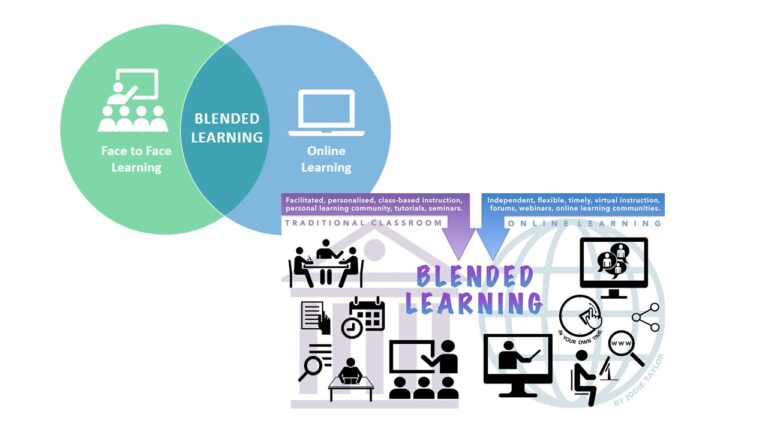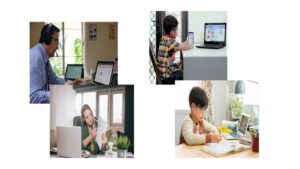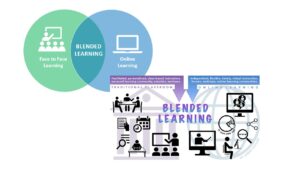
Blended Learning Will Become a Trend in the Post-COVID Era (By: Muchlas Samani)
When giving presentations about learning in the COVID-19 pandemic era, I always say that perhaps COVID-19 is part of Allah’s way of teaching educators a lesson. Haven’t we already experienced the use of digital technology (IT) in other fields? We almost never withdraw money from the bank anymore because it’s more convenient to use an ATM. Recently, we have been using mobile banking to send money to relatives or pay for something. When traveling by train, we buy tickets online and check in at the station using check-in machines. We have downloaded and read electronic magazines, journals, and books (e-magazines, e-journals, e-books). The question is, why haven’t we tried online learning (e-instruction)?
After being forced to conduct online learning for six months, it seems that teachers, lecturers, students, and university students are starting to get used to it. We also had to conduct meetings online. We must admit that there are many challenges and shortcomings. However, we must also acknowledge that there are some benefits we have gained from conducting online learning and meetings over the past six months. Not all topics/competencies can be delivered through online learning. Some can be done easily, some can be done but not easily, and some seem impossible to do online. Teachers and lecturers can certainly feel this. For cognitive aspects and informative levels, teachers can guide students to find information from various online sources. Google is one of the “guides.” However, when it comes to analyzing that information, intensive assistance is needed. Applying a formula also seems to require assistance. Skills-related topics that are simple and not dangerous can still be done, although not easily. However, if the movement or skill is complex and/or dangerous, it will be very difficult and require face-to-face assistance.
Not all topics/competencies can be delivered through online learning. Some can be done easily, some can be done but not easily, and some seem impossible to do online. Teachers and lecturers can certainly feel this. For cognitive aspects and informative levels, teachers can guide students to find information from various online sources. Google is one of the “guides.” However, when it comes to analyzing that information, intensive assistance is needed. Applying a formula also seems to require assistance. Skills-related topics that are simple and not dangerous can still be done, although not easily. However, if the movement or skill is complex and/or dangerous, it will be very difficult and require face-to-face assistance.
Some aspects of character and those related to “feelings” require role models, so physical interaction is necessary. It can be exemplified through videos, but at a certain stage, real role models are very much needed. Moreover, we understand that character development requires a long time and consistency in daily life.
On the other hand, online learning also has positive impacts. Students who usually rarely ask questions during face-to-face learning suddenly become active in asking questions and expressing opinions. Students become trained in finding information. During face-to-face learning, teachers tend to provide information through lectures, but during online learning, students are accustomed to finding it from online sources via the internet. Online meetings also turn out to be effective because participants can join from anywhere. Meeting participants also become more active. Recently, online seminars have become widespread, and many are free.
The question is, when the COVID-19 pandemic is over and schools have “reopened,” will online learning disappear, and will learning patterns return to the way they were before? Before trying to analyze, let me tell a story first. A few weeks ago, I met and chatted with a friend who is in the marketing world. He said that malls will change their function. They will not be places for buying and selling but places for people to stroll and window shop, as well as showrooms. So, where will the buying and selling take place? Online. People will go to the mall to see the goods, check the prices, and if necessary, try them out. But they will not buy them there. After finding the suitable item and being satisfied with window shopping, they will go home and buy it online from home. Why? Because the price is cheaper. This prediction has also been realized by entrepreneurs, so besides opening outlets in malls, they also provide online sales services.
Is it safe to buy all items online? Apparently not. If the item purchased is a standard product, such as a specific brand of shoes or clothes, it is said to be safe to buy online. But for unique items, such as batik clothes or gold jewelry that do not have specific standards, it is better to buy them directly.
What about GoFood? Will restaurants be empty after the pandemic ends? According to my friend, no. But they will change. People who go to restaurants or food stalls are those who want to eat while relaxing with friends. Besides, food often “changes taste” when taken home. Therefore, restaurants will not be as affected as non-food outlets in malls. Will GoFood or similar services stop? Also no. People who want to eat because they are hungry, not to relax, especially if they are lazy to go out of the house or office, will use GoFood. So both will continue to operate. So, what about the learning process in schools? I believe that even after the pandemic is over, online learning will continue. Not alone, but combined with “traditional learning.” This is called blended learning, or simply a mix of online and face-to-face learning. It does not mean that students will not come to school. Students can be in the classroom but studying the material online. It does not mean there are no teachers. Teachers are there, but their function is to help if students encounter difficulties. After some time of online learning, students can continue with problem-solving exercises conducted interactively with the teacher, similar to what was done before.
So, what about the learning process in schools? I believe that even after the pandemic is over, online learning will continue. Not alone, but combined with “traditional learning.” This is called blended learning, or simply a mix of online and face-to-face learning. It does not mean that students will not come to school. Students can be in the classroom but studying the material online. It does not mean there are no teachers. Teachers are there, but their function is to help if students encounter difficulties. After some time of online learning, students can continue with problem-solving exercises conducted interactively with the teacher, similar to what was done before.
What needs to be thought about and prepared now is which parts can or are more effectively done online and which parts require face-to-face interaction with the teacher. Regarding online or face-to-face learning, cognitive, affective, and psychomotor aspects may require different approaches. Elementary, middle, high school, and higher education levels may also require different approaches. All of this is still new, and no one has experience with it yet. It is best for all teachers, lecturers, and especially learning experts to innovate to welcome the new era, the era of blended learning. Hopefully.



